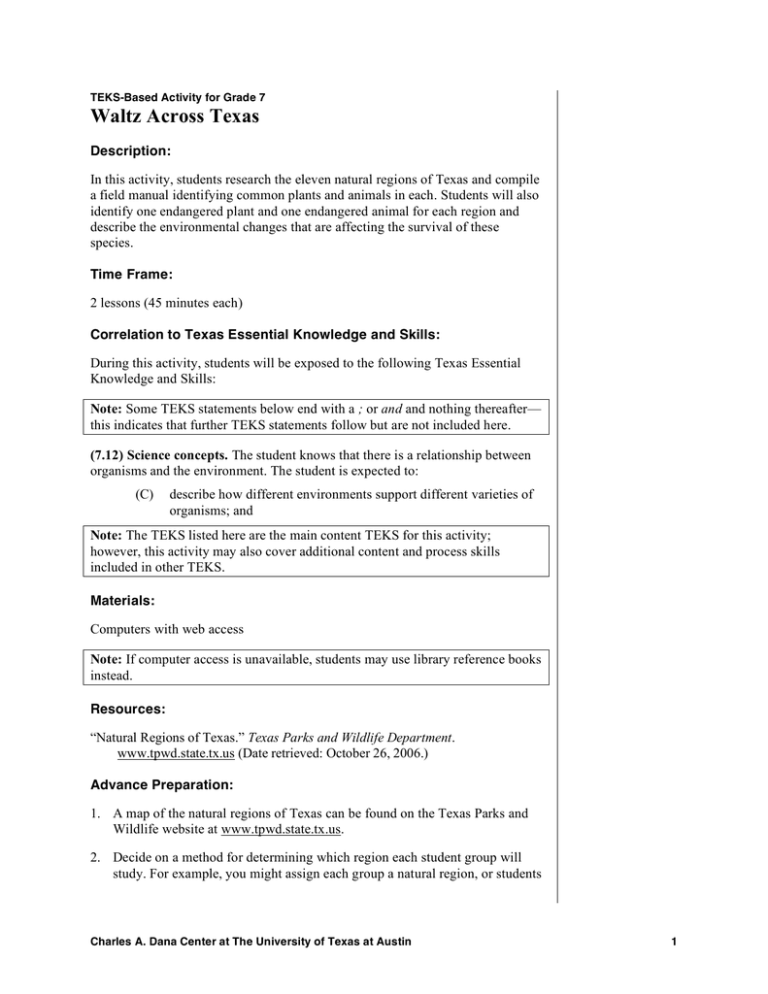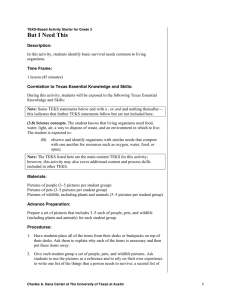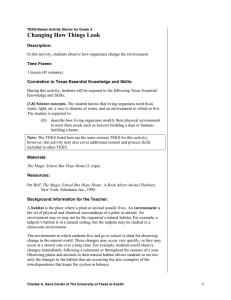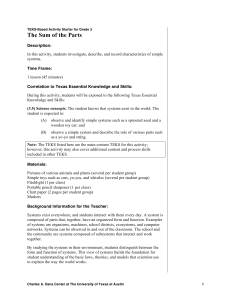Waltz Across Texas
advertisement

TEKS-Based Activity for Grade 7 Waltz Across Texas Description: In this activity, students research the eleven natural regions of Texas and compile a field manual identifying common plants and animals in each. Students will also identify one endangered plant and one endangered animal for each region and describe the environmental changes that are affecting the survival of these species. Time Frame: 2 lessons (45 minutes each) Correlation to Texas Essential Knowledge and Skills: During this activity, students will be exposed to the following Texas Essential Knowledge and Skills: Note: Some TEKS statements below end with a ; or and and nothing thereafter— this indicates that further TEKS statements follow but are not included here. (7.12) Science concepts. The student knows that there is a relationship between organisms and the environment. The student is expected to: (C) describe how different environments support different varieties of organisms; and Note: The TEKS listed here are the main content TEKS for this activity; however, this activity may also cover additional content and process skills included in other TEKS. Materials: Computers with web access Note: If computer access is unavailable, students may use library reference books instead. Resources: “Natural Regions of Texas.” Texas Parks and Wildlife Department. www.tpwd.state.tx.us (Date retrieved: October 26, 2006.) Advance Preparation: 1. A map of the natural regions of Texas can be found on the Texas Parks and Wildlife website at www.tpwd.state.tx.us. 2. Decide on a method for determining which region each student group will study. For example, you might assign each group a natural region, or students Charles A. Dana Center at The University of Texas at Austin 1 TEKS-Based Activities Grade 7—Waltz Across Texas might select which region they are interested in studying. Do not assign the students’ home region, as this will serve as the comparison region. 3. Make a poster of the home region that includes the information you want students to research. Students can use this poster as an example of how to proceed with the research of their selected natural regions. Procedures: 1. Have student groups visit the Texas Parks and Wildlife website to locate information about the region they are studying. Groups should research and record information on the characteristics that define the region, including average rainfall, temperature, and any other information you have asked students to research. 2. Groups will then research an endangered plant and an endangered animal within their selected region. The research should include any changes in the environment that have affected the survival of the species. 3. Have groups prepare an oral report on their regions. 4. As a class, construct a chart to record information about all the natural regions of Texas the groups have researched. As each group reports on their region, students add information to the class chart. Each report should list the endangered organisms of that region and the reasons why the organisms are endangered. 5. As a class, discuss the following questions. What natural environmental or man-made changes might help the organisms survive? [Answers will vary.] Do you think these changes are likely? Why or why not? [Answers will vary.] What modifications of the organisms’ traits would possibly help the organisms to survive? [Answers will vary.] Do you think these modifications are likely? [No.] Why or why not? [It takes many generations and the right mutations to produce the right modifications, and this is not likely to happen.] Charles A. Dana Center at The University of Texas at Austin 2






